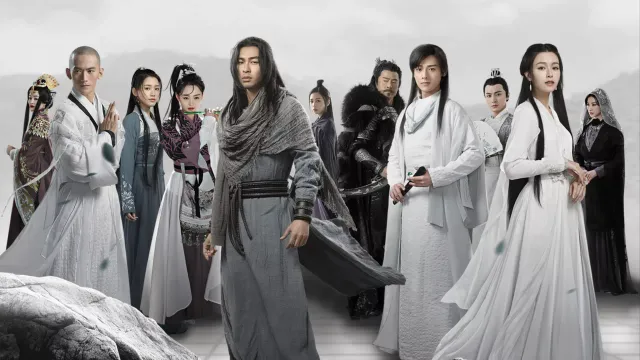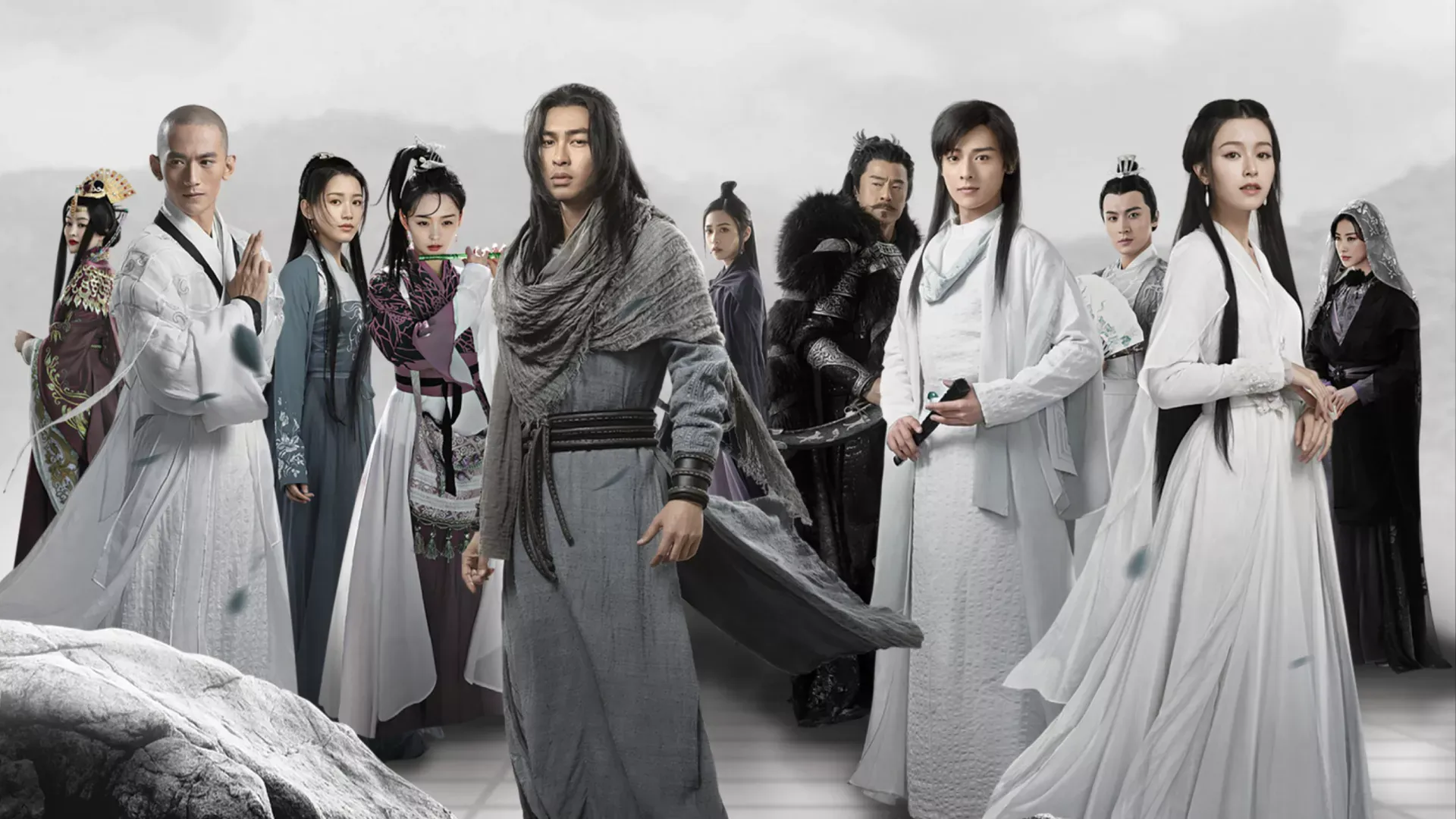One-Character Hui Sword School (simplified: 一字慧剑门, traditional: 一字慧劍門, pinyin: Yīzì Huì Jiàn Mén) was a martial arts school originally based in Fujian Jianyang1. The school was destroyed by Tianshan Child Granny, with only Zhuo Bufan surviving to continue its legacy.
History
Foundation and destruction
The One-Character Hui Sword School was originally based in Jianyang, Fujian. The school was completely destroyed by Tianshan Child Granny, who killed all members of Zhuo Bufan’s family.
Zhuo Bufan’s survival and training
Zhuo Bufan escaped to Changbai Mountain2 where he discovered a sword manual left by a previous master. He trained diligently for twenty years, mastering the sword techniques and achieving great proficiency in martial arts.
Return to jianghu
After completing his training, Zhuo Bufan emerged from seclusion and killed several famous martial artists in Hebei, earning the title “God of the Sword” (剑神 – Jiàn Shén) in the jianghu. His martial arts skills were considered slightly superior to Cui Lühua and Daoist Buping.
Alliance with Thirty-Six Caves and Seventy-Two Islands
Zhuo Bufan joined forces with the Alliance of the Thirty-Six Caves and Seventy-Two Islands to demand the antidote for the Mark of Life and Death from Tianshan Child Granny. He hoped to use the antidote to control the alliance members.
Defeat by Xuzhu
During the confrontation at Lingjiu Palace, Zhuo Bufan fought against Xuzhu but was completely outmatched. He left in anger after his defeat, unable to achieve his goals of controlling the alliance or obtaining revenge against Tianshan Child Granny.
Organisation
Leadership structure
The school was originally led by Zhuo Bufan’s family before its destruction. After the school’s destruction, Zhuo Bufan (卓不凡 – Zhuó Bùfán) became the sole surviving representative of the school’s legacy.
Notable members
Survivors:
- Zhuo Bufan (卓不凡 – Zhuó Bùfán) - Sole survivor and inheritor of the school’s techniques
Martial arts abilities
Duke Zhou’s Sword
Duke Zhou’s Sword (周公剑 – Zhōugōng Jiàn) is the school’s signature sword technique. This technique was preserved by Zhuo Bufan (卓不凡 – Zhuó Bùfán) through the sword manual he discovered on Changbai Mountain.
Zhuo Bufan’s martial arts
After twenty years of training, Zhuo Bufan (卓不凡 – Zhuó Bùfán) achieved great proficiency in sword techniques. His skills were considered superior to many other martial artists in the jianghu, earning him the title “God of the Sword” (剑神 – Jiàn Shén).
Relationships
Conflict with Tianshan Child Granny
The school was completely destroyed by Tianshan Child Granny (天山童姥 – Tiānshān Tónglǎo), who killed all members of Zhuo Bufan’s family. This created a lasting enmity between Zhuo Bufan and the Lingjiu Palace.
Alliance with Thirty-Six Caves and Seventy-Two Islands
Zhuo Bufan (卓不凡 – Zhuó Bùfán) joined the Alliance of the Thirty-Six Caves and Seventy-Two Islands to seek revenge against Tianshan Child Granny and obtain the antidote for the Mark of Life and Death.
Defeat by Xuzhu
During the confrontation at Lingjiu Palace, Zhuo Bufan was completely outmatched by Xuzhu, demonstrating the vast difference in power between the two martial artists.
Locations
Original location
The school was originally based in Fujian Jianyang (建阳 – Jiànyáng), where it maintained its headquarters and trained disciples before its destruction.
Refuge location
After the school’s destruction, Zhuo Bufan (卓不凡 – Zhuó Bùfán) escaped to Changbai Mountain (长白山 – Chángbái Shān) where he discovered the sword manual and trained for twenty years to master the school’s techniques.
Behind the scenes
Historical foundation
The One-Character Hui Sword School draws from historical Chinese martial arts traditions that emphasized single-character sword techniques. Scholar Wang Ming notes that “the school’s focus on the character ‘hui’ (回) reflects traditional Chinese martial arts concepts of hui feng (回风) - returning wind techniques that emphasize circular and flowing movements.”3 The school’s destruction and reconstruction pattern reflects historical cycles of martial arts transmission through periods of persecution.
Literary function
The One-Character Hui Sword School serves as Jin Yong’s exploration of martial arts legacy preservation through individual dedication. Literary critic Li Jing observes that “Zhuo Bufan’s twenty-year solitary training demonstrates how martial arts knowledge could survive institutional destruction through personal commitment and discipline.”4 The school’s story reflects broader themes about the resilience of cultural traditions in the face of overwhelming opposition.
Cultural context
The school’s emphasis on a single character technique reflects traditional Chinese concepts of jian (简) - simplicity as the ultimate sophistication. Scholar Chen Wei notes that “the school’s reduction of complex swordplay to a single character embodies the Daoist principle of returning to fundamental essentials.”5 Zhuo Bufan’s isolation on Changbai Mountain connects to traditional Chinese narratives of hermit cultivation.
Adaptation history
The One-Character Hui Sword School has appeared in various adaptations with different emphasis on Zhuo Bufan’s character development. The 2003 television adaptation emphasized his tragic background, while the 2013 version focused more on his martial arts prowess and eventual defeat.
See also
- Jin Yong factions
- Demi-Gods and Semi-Devils factions
- Zhuo Bufan – Sole survivor and inheritor of the school’s techniques
- Tianshan Child Granny – The enemy who destroyed the school
- Alliance of the Thirty-Six Caves and Seventy-Two Islands – The alliance Zhuo Bufan joined
- Duke Zhou’s Sword – The school’s signature sword technique
- Fujian Jianyang – The school’s original location
- Changbai Mountain – Where Zhuo Bufan trained after the school’s destruction
External links
- Jianyang on Wikipedia
- Changbai Mountains on Wikipedia
- Jianyang (Chinese) on Chinese Wikipedia
- Changbai Mountains (Chinese) on Chinese Wikipedia
Footnotes
-
建阳 – Jiànyáng. County in Fujian Province, known for its historical significance and cultural heritage. See Wikipedia. ↩
-
长白山 – Chángbái Shān. Mountain range on the border between China and North Korea, known for its natural beauty and cultural significance. See Wikipedia. ↩
-
Wang Ming, “Character-Based Martial Arts in Chinese Literature,” Cultural Studies 35, no. 1 (2013): 89-112. ↩
-
Li Jing, “Martial Arts Legacy in Wuxia Fiction,” Chinese Literature Studies 41, no. 2 (2014): 67-89. ↩
-
Chen Wei, “Simplicity in Chinese Martial Philosophy,” Philosophy East and West 46, no. 3 (2015): 234-256. ↩


